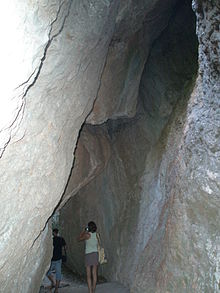Kiik-Koba
Kiik-Koba (also: Кїїк-Коба ; Ukrainian for "mountain goat cave") is an archaeological and paleoanthropological site in the south of the Crimean peninsula in the Crimean Mountains , 25 kilometers east of Simferopol . The cave was first explored by the Russian archaeologist Gleb Bontsch-Osmolowski (also: Gleb Bonč-Osmolovskij, 1890–1943) who, in addition to numerous stone tools , discovered two skeletons between 1924 and 1926 , which are interpreted as the remains of Neanderthals .
location
The cave is located seven kilometers south of the city of Suja ( Crimean Tatar Zuya , in Bilohirsk Raion ), to the right of the Suja River at 512 meters above sea level and around 90 meters above the river ( 44 ° 57 ′ 0 ″ N , 34 ° 21 ′ 0 ″ E ). It was formed by leaching out of limestone , which was formed in the Jura , and at the time of its first investigation was largely filled with sediment that has since been removed. The cave is nine meters deep, eleven meters wide, up to nine meters high and opens to the southeast.
Finds
The skeletons discovered in 1924, only partially preserved, were the first Neanderthals to be found in Eastern Europe and come from an adult - probably from a man around 40 years old - and a child who was no older than a year. Both corpses were placed directly next to each other in a recess and were dated on the basis of accompanying fossils in the transition from oxygen isotope level 5 to level 4, that is to the time around 73,000 years ago. One canine tooth , 17 bones in both hands, the kneecap , shin and fibula of the right leg and 53 bones in both feet have been preserved from the adult (archive number Kiik-Koba 1) ; from the child (Kiik-Koba 2) only numerous bones remained below the head, albeit in poor condition.
Another special feature was published in 2018: A flint with incisions, the layer of which was found to be 35,000 to 37,000 years old Cal BP ; the incisions were interpreted as possibly deliberately designed figurative engraving.
literature
- Yuri E. Demidenko, Thorsten Uthmeier et al .: Kiik-Koba Grotto, Crimea (Ukraine): Re-Analysis of a Key Site of the Crimean Micoquian. VML Verlag Marie Leidorf, Rahden / Westf. 2013, ISBN 978-3-86757-363-4 (= Cologne Studies on Prehistoric Archeology, Volume 3. Published for the Institute for Prehistory and Early History of the University of Cologne.)
- Yuri E. Demidenko: Kiik-Koba Grotto: Significance for Paleolithic Studies in East Europe and the Former Soviet Union. In: Claire Smith (Ed.): Encyclopedia of Global Archeology. Springer Science + Business Media, New York 2014, pp. 4281-4288, ISBN 978-1-4419-0426-3 . Full text
- Yuri E. Demidenko: Problems of Epochal and Industrial Attribution for Kiik-Koba Rock-Shelter, Lower Layer Type Complexes in the Crimea. In: Stratum Plus. No. 1, 2003-2004, pp. 271-300, abstract
Individual evidence
- ^ Bernard Wood : Wiley-Blackwell Encyclopedia of Human Evolution. Wiley-Blackwell, Chichester 2011, p. 383, ISBN 978-1-4051-5510-6
- ↑ Bonch-Osmolovsky, Gleb. On: encyclopediaofukraine.com , accessed May 3, 2018
- ↑ Kiik-Koba. On: encyclopediaofukraine.com , accessed May 3, 2018
- ↑ Erik Trinkaus et al .: Brief communication: Paleopathology of the Kiik ‐ Koba 1 Neandertal. In: American Journal of Physical Anthropology. Volume 37, No. 1, 2008, pp. 106-112, doi: 10.1002 / ajpa.20833
- ^ Erik Trinkaus et al .: The Appendicular Remains of the Kiik-Koba 2 Neandertal Infant. In: PaleoAnthropology. Volume 2016, pp. 185–210, doi: 10.4207 / PA.2016.ART103 , full text (PDF)
-
^ Ana Majkić et al .: Assessing the significance of Palaeolithic engraved cortexes. A case study from the Mousterian site of Kiik-Koba, Crimea. In: PLoS ONE. Volume 13, No. 5, 2018, e0195049, doi: 10.1371 / journal.pone.0195049
Engraved Crimean stone artifact may demonstrate Neanderthal symbolism. On: eurekalert.org from May 2, 2018

